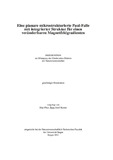Citation link:
https://nbn-resolving.org/urn:nbn:de:hbz:467-7797Files in This Item:
| File | Description | Size | Format | |
|---|---|---|---|---|
| kunert.pdf | 126.05 MB | Adobe PDF |  View/Open |
| Dokument Type: | Doctoral Thesis | metadata.dc.title: | Eine planare mikrostrukturierte Paul-Falle mit integrierter Struktur für einen veränderbaren Magnetfeldgradienten | Other Titles: | A planar micro-structured Paul trap with an integrated structure for a versatile magnetic field gradient | Authors: | Kunert, Peter Josef | Institute: | Fakultät IV - Naturwissenschaftlich-Technische Fakultät | Free keywords: | Quantenoptik, Ionenfalle, Oberflächenfalle, Quanteninformationsverarbeitung, quantum optics, ion trap, surface trap, quantum information processing, MAGIC | Dewey Decimal Classification: | 530 Physik | GHBS-Clases: | UHED UHEQ |
Issue Date: | 2013 | Publish Date: | 2014 | Abstract: | In einer Paul-Falle gespeicherte, laser-gekühlte atomare Ionen können als elementare quantenmechanische Schalteinheiten für die Quanteninformationsverarbeitung (QIV) genutzt werden. Hierfür muss die Adressierung einzelner Ionen und die Wechselwirkung der Ionen untereinander gewährleistet werden. Hierzu wurde ein Konzept (magnetic gradient induced coupling, MAGIC) vorgeschlagen, welches einen Magnetfeldgradienten ausnutzt, um Ionen im Frequenzraum mittels Strahlung im Radiofrequenz- oder Mikrowellen-Bereich zu adressieren. Dabei wird die magnetfeldabhängige Aufspaltung der inneren Zustände der Ionen ausgenutzt. Zusätzlich kann eine Spin-Spin Kopplung zwischen den gespeicherten Ionen in einer Kette realisiert werden. In dieser Arbeit werden erste Ergebnisse präsentiert um eine Oberflächenfalle für die QIV im Zusammenhang mit dem Konzept MAGIC nutzbar zu machen. Diese neuartige Falle ist eine miniaturisierte, segmentierte Paul-Falle, bei der die zum Speichern von Ionen notwendige Elektrodenstruktur auf eine einzige Ebene verlagert werden kann und Ionen oberhalb dieser Ebene gespeichert werden können. Es wird die Infrastruktur für die Herstellung einer Oberflächenfalle an unserem Institut geschaffen und mittels optischer Lithographie und Galvanik wird ein Fallenchip mit einer Elektrodendicke von 8,5 µm mit einer Oberflächenrauheit von 20-30 nm produziert. Dieser beinhaltet eine neuartige stromdurchflossene Struktur, die es erlaubt einen räumlich und zeitlich variablen Magnetfeldgradienten am Ort der Ionen zu erzeugen. Das Speichern von 172Yb+ Ionen über einige Stunden hinweg wird demonstriert. Mit Hilfe der Radiofrequenz-optischen Doppelresonanz-Spektroskopie wird der Magnetfeldgradient vermessen. Erstmals ist an einer Oberflächenfalle eine Adressierung im Frequenzraum von drei Ionen mittels angelegtem Gradienten demonstriert worden. Die Güte der individuellen Adressierung der Ionen beträgt F = 0,52(1). Diese ist aktuell durch Imperfektionen der zuführenden Leiterbahnen begrenzt. In naher Zukunft sollten Gradienten um 20 T/m realisierbar sein, was zu einer Güte nahe 1 führen sollte. Laser-cooled atomic ions, stored in a Paul trap, can be used as elementary quantum mechanical units for quantum information science. For this purpose, addressing of individual ions and deterministic coupling between the ions have to be provided. A static magnetic field gradient applied to a Wigner crystal of trapped ions allows for addressing of individual ions in frequency space, if the ions’ energy levels are magnetic field dependent. At the same time this field gradient induces spin-spin coupling (magnetic gradient induced coupling - MAGIC) between ions that can be used for conditional quantum gates. Both, addressing and conditional quantum gates can be carried out using radiation in the radio-frequency and microwave regime. In this thesis first results to use a surface trap in quantum information science using MAGIC are presented. This novel kind of ion trap is a miniaturized, segmented Paul trap with electrodes placed in one single plane. Using micro-system technology for fabrication it is possible to produce complex two-dimensional electrode structures. During the course of this thesis the infrastructure was established to produce a surface trap chip at our institute. A trap chip was fabricated using optical lithography and electroplating with a resulting electrode-thickness of 8,5 µm and a surface roughness of 20-30 nm. This chip integrates a novel current-carrying structure to provide an arbitrary magnetic field distribution at the ions’ position. Trapping of 172Yb+ ions with storage times of hours is demonstrated. Employing radio frequency-optical double-resonance spectroscopy the magnetic field gradient is characterized. For the first time, individual addressing in frequency space in a surface trap is demonstrated. For three ions an addressing fidelity of F = 0,52(1) was demonstrated. This value is currently limited by imperfections of the circuit paths of the carrier. In the near future gradients up to 20 T/m should be achieved leading to an addressing fidelity close to unity. |
URN: | urn:nbn:de:hbz:467-7797 | URI: | https://dspace.ub.uni-siegen.de/handle/ubsi/779 | License: | https://dspace.ub.uni-siegen.de/static/license.txt |
| Appears in Collections: | Hochschulschriften |
This item is protected by original copyright |
Page view(s)
470
checked on Nov 28, 2024
Download(s)
139
checked on Nov 28, 2024
Google ScholarTM
Check
Items in DSpace are protected by copyright, with all rights reserved, unless otherwise indicated.

